The hospitality industry is highly competitive, so it’s crucial to make the most of every single room. This is where the magic – or should we say science? – of yield management comes into play. It's all about using data to maximize sales, keep your property full, and ultimately boost profits.
This article explores yield management techniques and describes various pricing and selling strategies that will help you best manage your room inventory.
What is yield management in hospitality?
Yield management is a strategy for maximizing revenue from room bookings by adjusting prices based on factors such as demand, seasonality, and booking patterns. It involves understanding, anticipating, and influencing consumer behavior, as well as finding the optimal balance between occupancy and rate.
In other words, yield management is about understanding what customers want and when they want it, varying pricing and sales approaches accordingly to make as much money as possible.
Yield management originated in the aviation industry in the 1970s as a strategy to increase revenue by dynamically adjusting prices based on demand fluctuations and customer segmentation. This concept evolved over time and penetrated other industries, notably hospitality, where hotels began employing similar techniques to boost their revenue.
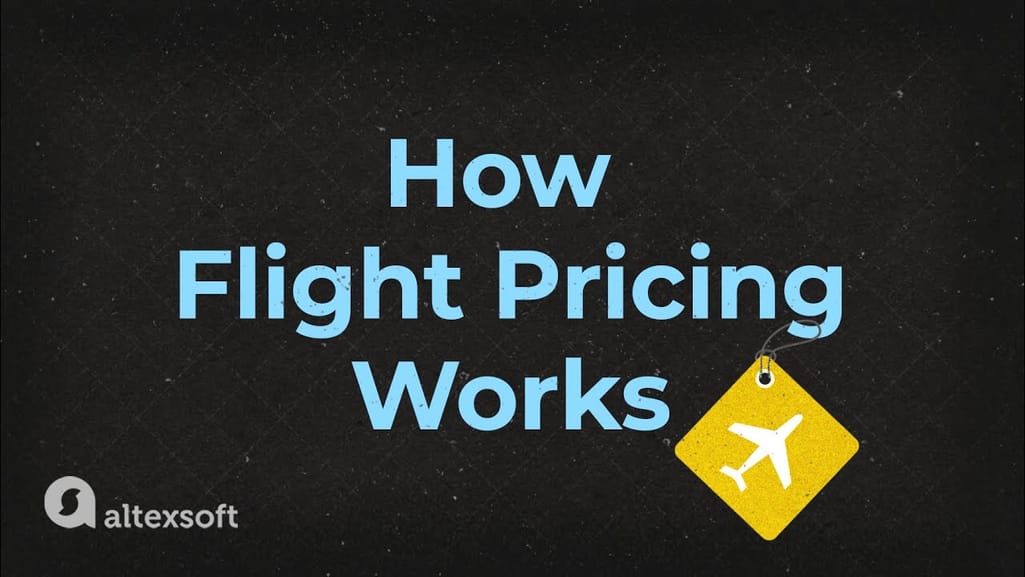

Today, multiple industries rely on sophisticated algorithms and data analysis to forecast demand and set prices accordingly, aiming to achieve the highest possible yield from available inventory.
Besides maximizing revenue, other benefits of yield management include
- tight control over inventory that leads to increased efficiency, better resource allocation, and minimization of both overbooking and underbooking;
- competitive advantage over other businesses that might not be implementing such sophisticated strategies; and
- better market and customer understanding that allows for more personalized service and marketing.
Before we dive deeper into yield management intricacies, let’s first briefly clarify its place among other hospitality concepts.
Yield management vs revenue management
Yield management and revenue management are often used interchangeably in the hospitality industry, but they have distinct focuses, despite their overlapping goals of maximizing income.
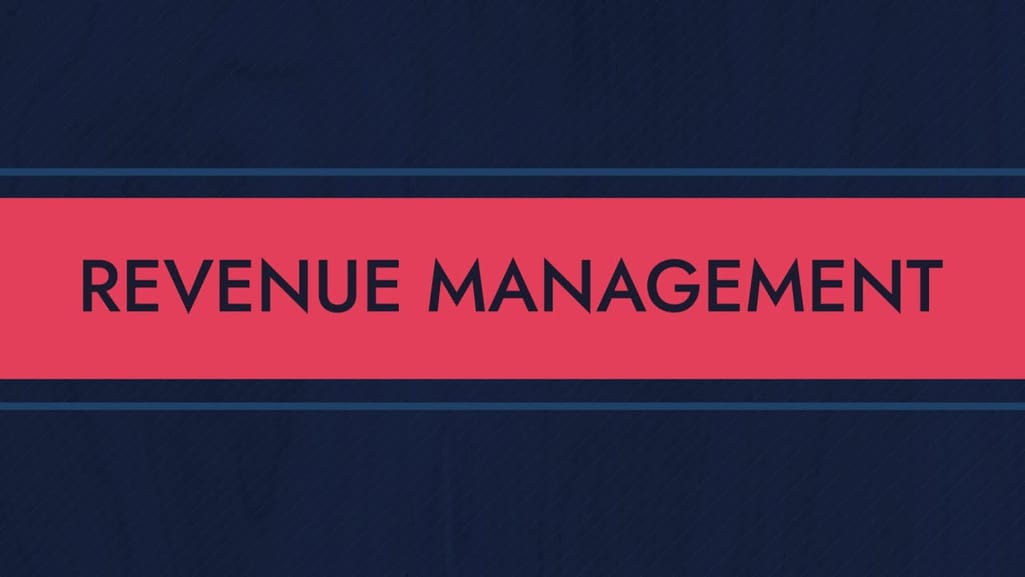

Yield management primarily focuses on balancing prices and availability to maximize the revenue generated from inventory. The key here is managing the yield or return from each room, which involves adjusting prices based on demand forecasts.
Revenue management takes a broader approach. While it includes yield management methods, it also encompasses a wider range of activities contributing to the overall revenue. This can include not just selling rooms but also
- managing distribution channels,
- upselling services,
- creating additional revenue sources,
- using various marketing strategies to capture more customer segments, and
- implementing personalization techniques to attract more guests by enhancing their experience.
In summary, while yield management focuses on maximizing the revenue from each unit of inventory by adjusting prices and sales based on demand, revenue management takes a holistic view of all revenue streams and strategies to increase the ultimate income.
Yield management vs traditional pricing
The main difference between yield management and traditional pricing strategies lies in the usage of advanced data analysis, forecasting techniques, and automation.
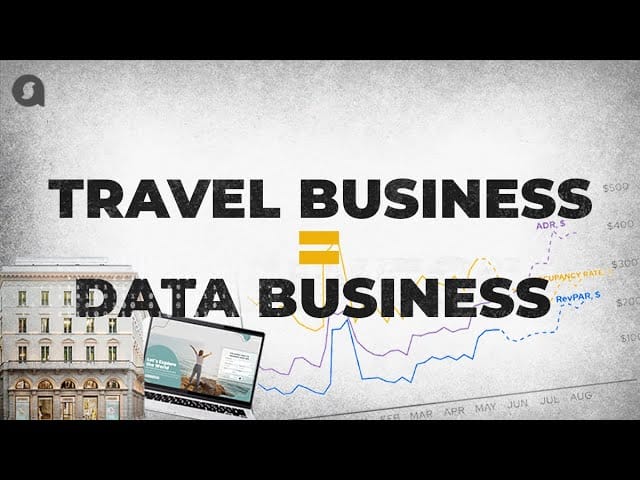

For example, traditionally, the product rate equals the costs involved plus a seller’s margin (so-called cost-based pricing). Then the rare times when prices are changed, it’s usually because of the season or substantial market fluctuations. Meanwhile, yield management employs dynamic pricing, constantly adjusting rates based on the analysis of multiple factors.
Also, unlike the traditional approach, yield management closely intertwines pricing decisions with inventory management, setting various booking restrictions (e.g., minimal or maximal length of stay). In addition, traditional pricing doesn’t differentiate between customer segments as precisely as yield management does.
In our comparisons, we’ve already started describing the main yield management elements, so let’s take a closer look and discuss them in more detail.
Key components of yield management
Hotel yield management is based on several statements that enable revenue managers to develop and apply various pricing strategies.
- Hotels have limited capacity as there’s a fixed number of rooms to sell.
- Hotel inventory is perishable (you can’t sell the room for yesterday).
- Different people are willing to pay different amounts for the same room under different conditions.
Given this knowledge, yield management encompasses various techniques and approaches that make its strategies possible. Here are the main ones.
Customer segmentation
Not all customers will pay the same price, so you have to figure out how to sell more expensive rooms to people willing to spend more – and find the best deals for other guest categories.
To define these categories or segments, hotels scrutinize their guests’ data and booking patterns. The main hospitality market segments are
- transient travelers – those who travel without any group and book at public, non-negotiated rates or so-called Best Available Rates (BARs);
- groups – multiple people who travel together and usually make reservations long in advance at discounted rates;
- corporate travelers – those who travel for business and book through their organization or travel management company, often at prenegotiated rates;
- wholesale – intermediaries like bed banks or tour operators booking in bulk with a discount; and
- SMERF – Social, Military, Educational, Religious, and Fraternal travel groups that also receive special, preferential booking conditions.

You can then break all these major segments down into smaller groups for more granular analysis. Numerous factors can be taken into account, like demographics (traveler age, gender, marital status, nationality, etc.), trip purpose (leisure or business), or booking channel (online or offline, direct or indirect).
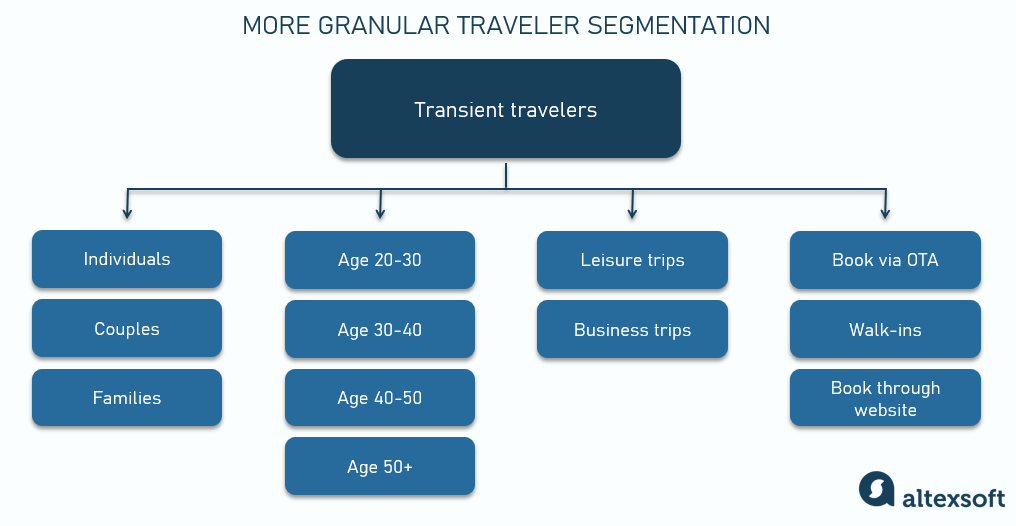
Travelers in each category show similar behavior patterns such as sensitivity to pricing, amenity choices, booking window, percentage of cancelations or no shows, etc.
Knowing all this data, it makes sense to treat each segment differently. You can tailor your services, marketing efforts, and, most importantly, pricing to meet each travel group's needs, attract more guests, and ultimately increase revenue.
After hotels segment their customers, they try to predict the demand of each group as accurately as possible.
Understanding demand
Customer demand constantly fluctuates based on various factors. Seasonality, especially for properties located at popular vacation destinations, is one such factor. So are big holidays like Christmas or important local events like sports competitions, trade shows, or festivals.
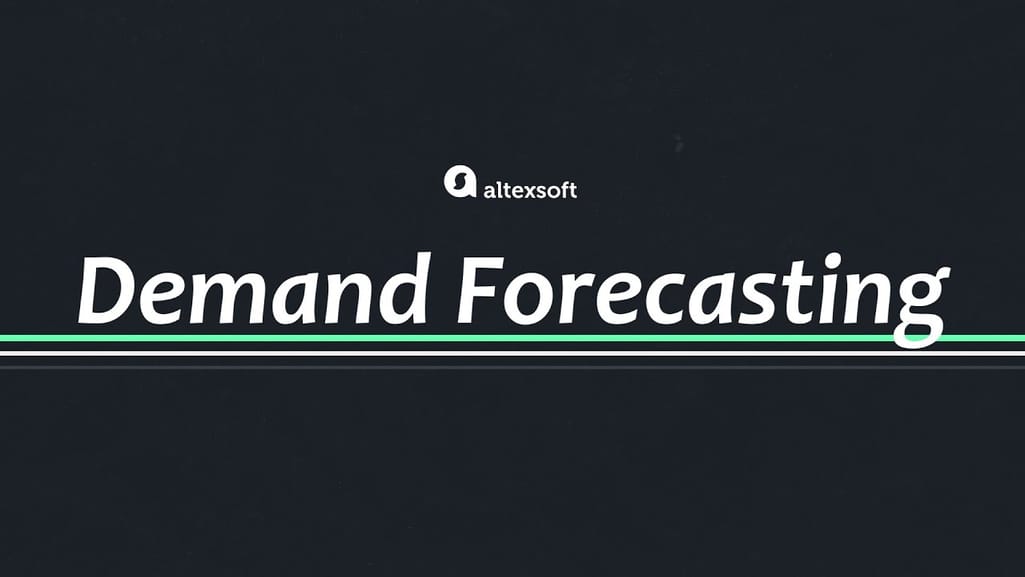

Demand forecasting lies at the very core of yield management. Hotels use past information and knowledge about current trends and future events to predict booking patterns and adjust prices accordingly.
Adjusting prices
Just like customer demand, hotel rates aren’t static. They can be adjusted based on various incoming data, mainly related to supply and demand. Simply speaking, hotels change their prices depending on how many people want to book. If, for whatever reason, many people want a room, the price goes up. If not many people are booking, the price decreases to maximize room sales.
In addition, room rates can be negotiated so that preferred distribution channels or frequent customers get discounted rates. So revenue managers constantly play with prices to secure the best deals and attract maximum business to the property.
Implementing technology
Everything we described above will not be efficient or accurate if done manually. You simply can’t obtain granular insights into customer segments, predict demand for each group in the long term with all factors considered, or juggle thousands of room rates without sophisticated software systems.
There are numerous tools designed to streamline hospitality operations. Some are more comprehensive, e.g., property management systems help control all the activities in the hotel, while others are responsible for a specific task, for example, booking engines capture and process online reservations.
Today, these tools are becoming more powerful than ever as they employ advanced AI technologies. Finely tuned machine learning models allow revenue managers to process previously unimaginable amounts of data. ML-powered platforms can simulate various what-if scenarios to choose the best-performing option, incorporate numerous variables to capture the slightest demand fluctuations and customer behavior patterns, and come up with prices that will optimally match the traveler's willingness to pay.
For example, we at AltexSoft have hands-on experience in developing an ML-based price prediction tool for a property owned by Rakuten Travel, a Japanese booking platform. To find an optimal price-demand ratio, we built two ML models: One used competitor pricing data to forecast the market ADR (average daily rate), and the other predicted occupancy based on the price levels. This way, revenue managers could see how different rates impact occupancy and choose the most revenue-beneficial scenario.


Yield management is mainly supported by RMS – revenue management software. It automates all the activities we discussed, calculating the best rates for predicted demand levels across segments and suggesting the optimal course of action. It also determines which booking requests comply with your current reservation policy (we’ll talk more about it in the next section) and must be approved.
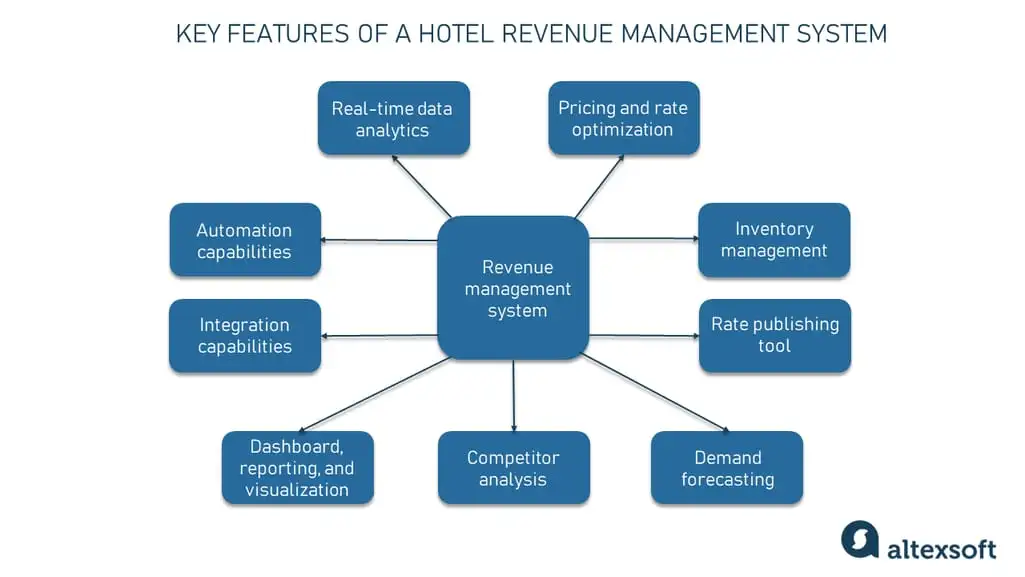
In addition, RMS generates detailed reports, offering granular insights into your property performance – another essential element worth mentioning.
Performance monitoring
You can’t control what you can’t measure. So you must calculate and monitor various KPIs to understand your position in the market, the effectiveness of your strategies, and areas that require improvement.
Besides the general overview of hotel KPIs, we have a series of detailed posts on the most important ones such as occupancy rate, average daily rate (ADR), and revenue per available room (RevPAR), so check them out for more insights on how to approach these metrics.
Also, take a look at our case study on AltexSoft developing a business intelligence tool that helped monitor vacation rentals’ performance and predict their occupancy rates.
Now that we’ve discussed what yield management is about, let’s finally talk about the different strategies you can apply to build up your returns.
Yield management strategies
As mentioned above, yield management's main challenge is finding an optimal balance between room rates and sales volume to achieve the maximum total yield. With this purpose, revenue managers apply various demand-based pricing and reservation strategies that aim to maximize occupancy – at the highest rates possible.
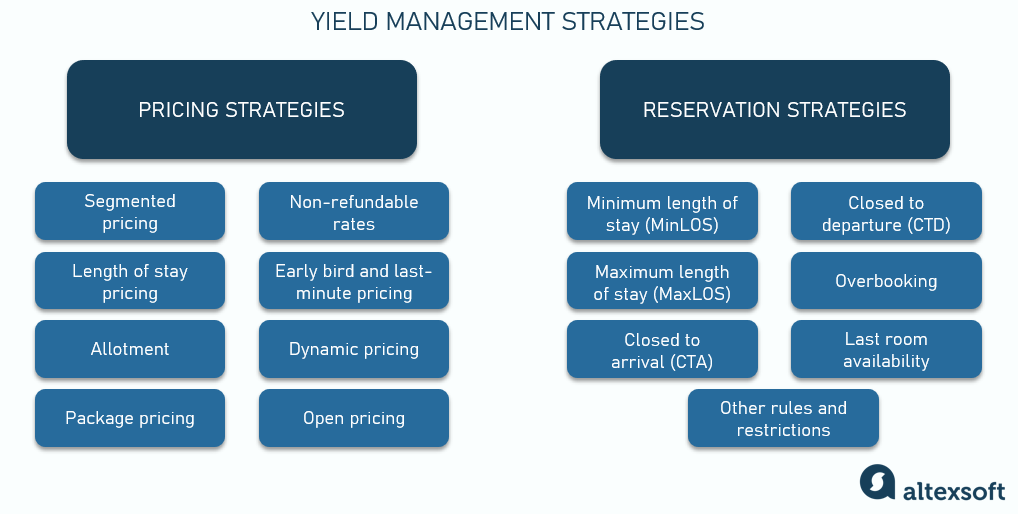
Yield management pricing
Obviously, pricing strategies involve managing room rates. Many hotels limit their pricing activities to developing separate rate plans for different room types and adjusting them seasonally. But there’s more you can do.
Note that most pricing strategies involve offering incentives to attract more guests. You must carefully calculate discounts to ensure that increased occupancy results in higher revenue despite lower margins.
Segmented pricing. You can offer different prices to different customer segments. For example, you can provide special rates for large bookings, such as group tours, weddings, conferences, or other events. You can also use other segmentation criteria such as age (e.g., discounts for seniors or students) or membership in loyalty programs (which not only drives direct bookings but also fosters customer loyalty and repeat business.)
Length of stay pricing. Prices are adjusted to the duration of a guest's visit. Longer stays might be incentivized with lower rates per night to encourage guests to extend their bookings, which ensures more stable occupancy rates.
Allotment. You can offer discounts to travel wholesalers or resellers (e.g., bed banks, tour operators, event organizers, etc.) and sell rooms in bulk.
Package pricing. One more strategy is to package rooms with other services such as meals, spa treatments, or local tours. These packages can then be priced more attractively compared to purchasing each component separately, appealing to guests looking for convenience and added value.
Non-refundable rates. Offering non-refundable rates at a discount can attract price-sensitive customers while providing the hotel with guaranteed revenue, even if the guest cancels.
Early bird and last-minute pricing. Offering discounts to guests who book well in advance (early bird) or close to the date of stay (last minute) can help manage occupancy rates by securing reservations early or filling up remaining rooms.
Dynamic pricing. Dynamic pricing is a more complex and technology-demanding approach. It involves constantly adjusting room rates based on various factors such as demand, time of booking, market trends, and competitor pricing. To make the price adjustment process really dynamic, hotels implement advanced data analytics systems that process massive amounts of assorted data in real time and automatically respond to changes in demand.
You can read more about ML-based dynamic pricing and the role of ML in revenue management overall in our dedicated posts.
Open pricing. Open pricing takes the previous strategy a step further. It offers an even more flexible and personalized approach by setting revenue-beneficial rates independently for different distribution channels or market segments.
For example, while a traditional approach implies closing out discounted channels (e.g., OTAs) in periods of high demand, open pricing suggests using a range of flexible price points for different room types, customer segments, booking channels, etc.
Visit our detailed overview of the open pricing strategy to learn more.
Yield management reservation strategies
The second category of yield management strategies doesn’t deal with price-setting. It’s about developing specific reservation policies that encourage longer stays or increase occupancy in other ways.
What’s crucial here is to carefully track turnaway business reports to see if your restrictions actually lead to increased revenue. You must balance the potential revenue gains from longer stays against the risk of turning away potential guests seeking shorter stays.
Also, keep in mind that guests who have a reservation refused might not be too happy about it, so monitor customer sentiment closely and pay attention to how your policies are communicated to the public.
Minimum length of stay (MinLOS). Consider requiring guests to book a minimum number of nights, especially during peak periods or special events. This ensures higher occupancy levels for a continuous period and maximizes revenue during high-demand times.
For example, you might require a minimum 3-night stay during a major holiday weekend or festival, preventing guests from booking only the most in-demand night.
Maximum length of stay (MaxLOS). Conversely, you can set a maximum stay limit to prevent long-term bookings that could block shorter, more profitable stays, particularly in periods of fluctuating demand. This restriction can also be used to limit use of discounted rates.
Closed to arrival (CTA). Under this strategy, hotels may restrict guests from checking in on certain days. You can implement this strategy to lighten the workload of the front desk and housekeeping teams on a busy day or when the arrival day would start a stay that conflicts with other booking rules.
For example, if your hotel is mainly busy on weekends, you can set a CTA restriction for Saturday bookings to encourage Friday to Sunday reservations. Or suppose you have an upcoming local event. In that case, you can restrict bookings on that day to promote reservations starting before the event day, avoid overload, and ensure smooth property operations.
As an expansion of CTA, you can set so-called close out or block out periods when you don’t accept reservations from certain distribution channels or for a specific duration of stay because you count on more profitable deals, for example, prioritizing direct bookings over indirect ones or longer stays over one-day visits.
Closed to departure (CTD). Similar to CTA, this restriction prevents guests from checking out on specific days. It's often used to optimize room availability for incoming guests and ensure continuous occupancy.
Overbooking. To counteract the effect of no shows and cancellations, hotels might overbook rooms, anticipating that a certain percentage of guests won't arrive. This strategy requires careful management to avoid negative guest experiences if the hotel cannot accommodate all bookings.
Last room availability. To support last minute reservations for business travelers from your corporate partner, you can set aside an agreed number of rooms at a prenegotiated rate.
Other rules and restrictions. Depending on the booking patterns of your hotel, you can set other reservation requirements or incentives. For example, a Saturday-night stay may be required to receive a discounted room on Monday. Or, just like a supermarket's “buy 2, get 1 free” deals, you can offer a free stay (or other incentives) for booking a certain number of nights.
These strategies can be used alone or in combination, depending on the hotel's specific goals, market conditions, and customer segments. Again, the critical point you must keep in mind when developing your yield management strategy is that your goal is to maximize revenue by balancing price, occupancy, and, of course, a positive guest experience.
Yield or revenue?
The attitude of industry experts toward yield management has been changing over the last decades. In its early days (1980s-1990s), it was seen as an innovative and effective pricing strategy to increase property profitability.
See Also
However, the development and adoption of analytical tech solutions enabled a more holistic approach aka revenue management. So in the 2000s, the terms yield management and revenue management started to be used interchangeably, and modern hospitality professionals even tend to consider yield management limited, ineffective, and largely obsolete.
So employing diverse revenue management techniques – including but not limited to yield management – offers a bigger potential to optimize the financial results of a business.
See Also
As we mentioned above, beyond just selling rooms, revenue management oversees all potential revenue sources, such as food and beverage, wellness products, conferences and events, and ancillary services. By optimizing each stream, a business can significantly increase its bottom line.
Revenue management also involves close control over distribution, developing an optimal mix of booking channels and sales partners – and adjusting it depending on the market situation. In addition, revenue management implies developing various marketing strategies to attract new guests and retain existing ones.
In summary, while yield management is an important tool for administering room-generated revenue and occupancy, a holistic revenue management strategy offers a more comprehensive framework that potentially leads to higher earnings by considering all aspects of the business.

Maria is a curious researcher, passionate about discovering how technologies change the world. She started her career in logistics but has dedicated the last five years to exploring travel tech, large travel businesses, and product management best practices.
Want to write an article for our blog? Read our requirements and guidelines to become a contributor.

